
The newest Magic: The Gathering expansion set is none other than Kaldheim, and ever since the December 2020 previews, players have been preparing themselves for all-out Viking warfare on this frosty, aurora-lit world. The Kaldheim set features many powerful tribes, plus some exciting new mechanics such as Foretell and Boast.
Novice players can use this set as a jumping-in point with style, along with beginner-friendly Core Sets, and experienced players will definitely get the most out of this set. Players of all stripes are encouraged to review this set color by color and tribe by tribe to see exactly how the pieces fit together for games of booster draft Limited.
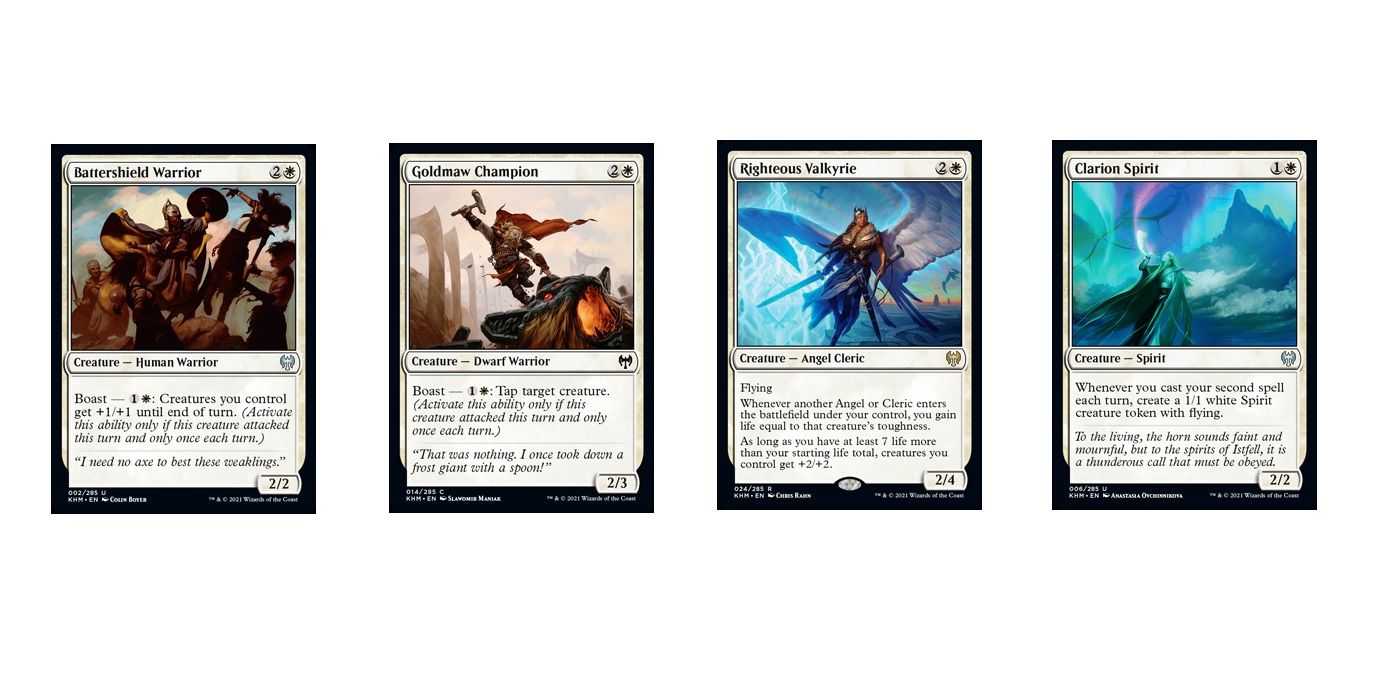
White mana is known for many things, and while it's a slow color as a whole, it is capable of aggression. Some of Kaldheim's white cards fit neatly with red cards to form a Boros-colored Dwarf aggro tribe, augmented with colored and colorless Equipment cards, Vehicles and power-boosting auras.
Players wanting a fast white deck are urged to consider Boros Dwarves. White mana may also slow down just a bit and join forces with green to form a green-white Human beatdown deck. This archetype combines Humans with Angels and makes use of team-pumping effects, +1/+1 counters and Boast to gain a tactical edge.
Or, white mana may be drafted with its polar opposite, black mana, to form a midrange Limited deck focused on evasive Angels, lifegain, sacrificing creatures, +1/+1 counters and casting two spells per turn, something many smaller creatures benefit from. Such a deck often uses Clerics, given its colors, and this fits with the Clerics of Zendikar Rising as part of the Party mechanic. When white mana combines with its ally blue, the result is a slow but inevitable control deck based on the Spirit creature type and Foretelling many cards to trick the opponent. White is tied with Blue when it comes to Foretell.
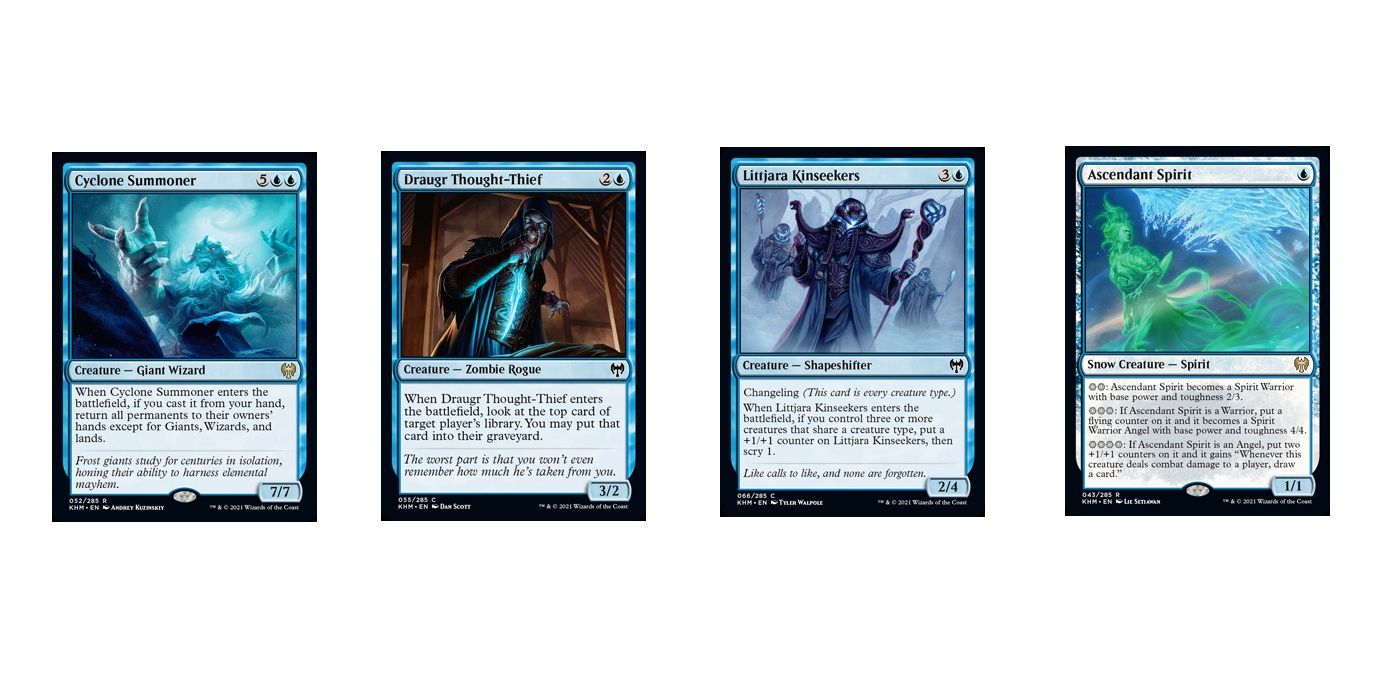
Blue mana is as tricky as ever. It's a flexible color that cares about everything from self-mill and Zombies to control spells, Giants and even Shapeshifters. Blue, when combined with red, forms the blue-red Giant Wizard tribe, which relies on Wizards in the early game and Giants as finishers. The Giants crush the opponents underfoot, while the spells and Wizards disorient and slow down the opponent with bounce effects, countermagic and burn spells.
Blue can also team up with green to form the Shapeshifter tribe, which can easily accommodate creatures of another tribe (colors permitting) and go to war. Green and blue often deal with tribal synergy and +1/+1 counters, and together, these colors also care a lot about Snow cards, though that's not required.
Blue and black form a self-mill deck that revives Zombies from the graveyard to enable a grindy strategy, or it may exile those creatures or make tokens based on them with either blue or black mana (this deck includes the legendary Narfi, Betrayer King). Finally, Blue may ally with white to make a Spirit-based control deck, and Ascendant Spirit is like the new Figure of Destiny, Snow-style.
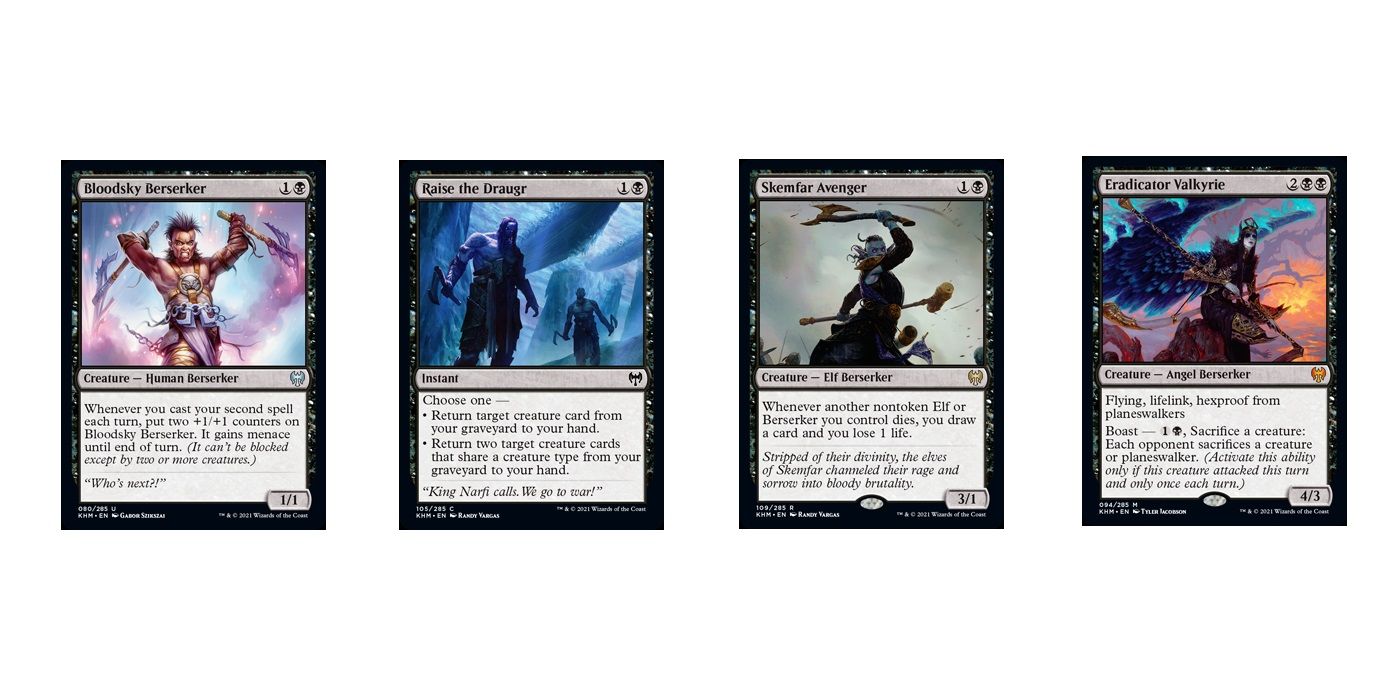
Black mana focuses mainly on the Zombie, Angel, Cleric, Berserker and Elf creature types, and some of these may fit into more than one deck. The white-black Angels deck can use powerful flying black Angels to beat down the opponent, and creatures like Bloodsky Berserker fit into that deck as well thanks to the "two spells matter" effect. Interestingly, Eradicator Valkyrie fits not only in the white-black deck, but also the black-red aristocrats deck, since it can attack and sacrifice a creature to thin out the opponent's board state at the same time.
Many other black or black-red cards either want to be sacrificed -- or do the sacrificing themselves. Black creatures and spells are critical for the self-mill deck, with Raise the Draugr efficiently bringing back two Zombies that were either destroyed in combat or milled away. This card also fits the aristocrats deck if the chosen creature type is Bererker, Human or Demon rather than Zombie. And the Elf tribe of Kaldheim gets most of its removal effects from black mana, while green mana takes care of creature pumping. Green can't easily draw cards, but Skemfar Avenger sure can, and it's an Elf.
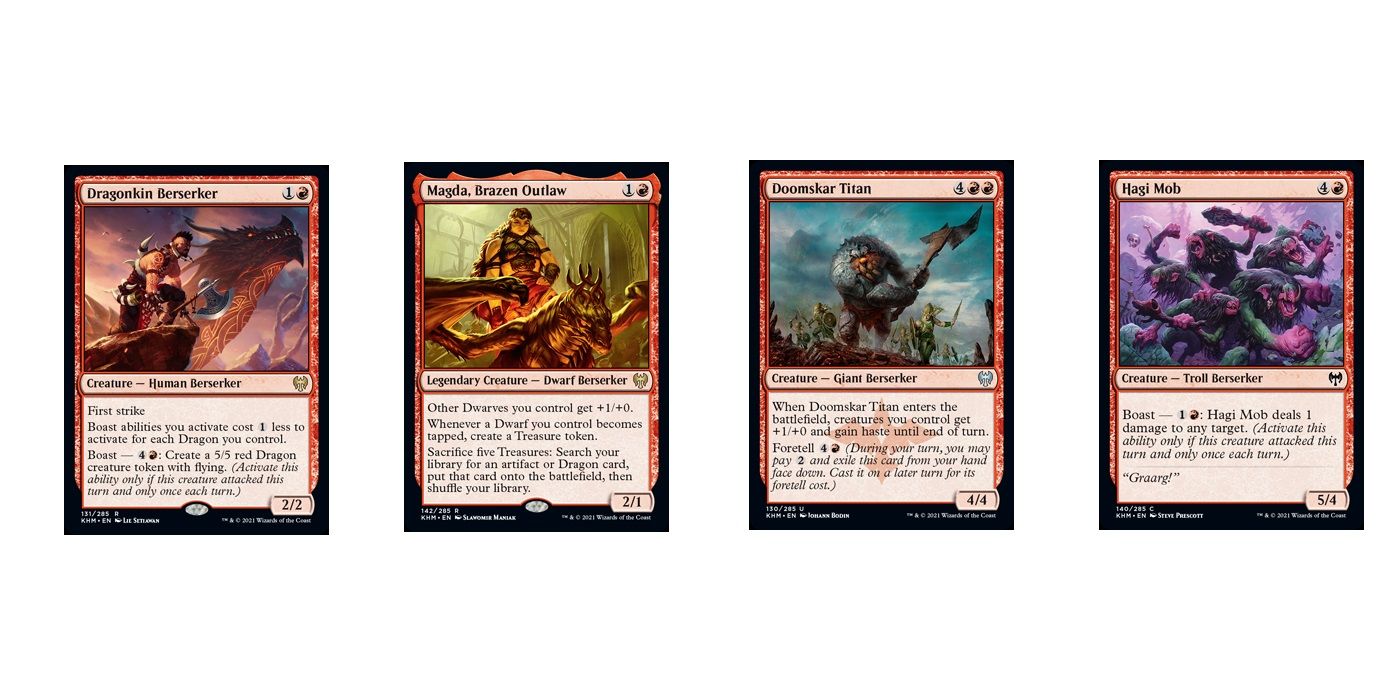
Red mana makes up the other half of the aristocrats deck in Kaldheim, though it doesn't focus as much on artifacts as the black-red aristocrats deck from Commander Legends. Instead, red and black creatures are Boasting in this deck, and Dragonkin Berserker makes those Boast abilities cheaper if dragons are around. Similarly, Frenzied Raider (a small red Demon) gets a +1/+1 counter each time a friendly creature uses Boast.
The Dwarf tribe is primarily red, and Magda, Brazen Outlaw embodies nearly every aspect of this red-centered tribe. Dwarves care about Treasure tokens, Vehicles (first seen in the Kaladesh block), Dwarf tribal and power boosting. In fact, this tribe can melt down Treasure tokens to revive Gilded Assault Cart, a red Vehicle with impressive power.
Red is also involved in the Giant deck, contributing massive creatures that can deal serious damage, while the blue cards keep the opponent pinned down. Red mana also appears in the Troll deck, though green is the dominant color for that archetype. Still, red is doing its part with cards like Hagi Mob and any variety of burn spells and instants that pump up attacking creatures. Green is tough, but it needs red for that vital speed.
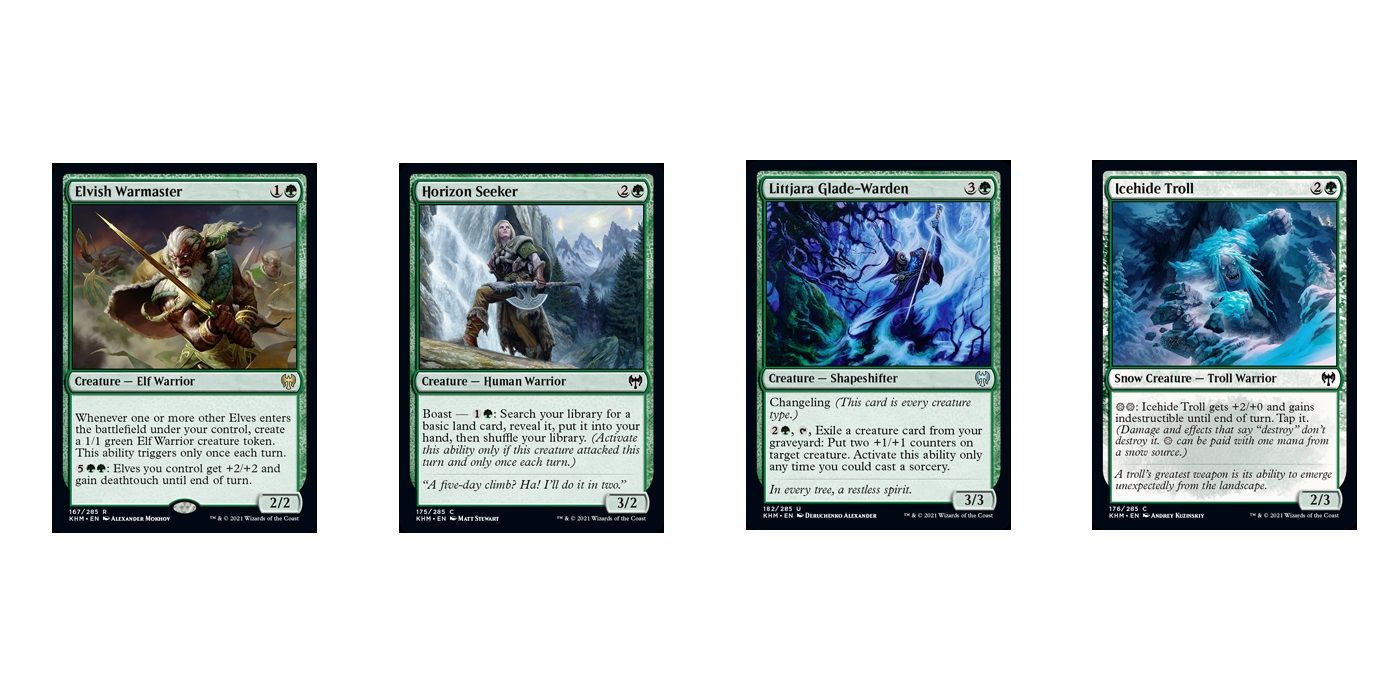
Green mana is focused on a handful of tribes, and along with blue and red mana, it is strong with the Snow card type as well. The color can form strong Snow decks even without serious tribal support. This is the main component of the Elf deck, providing most of the creatures across the mana curve and contributing mana ramp as well. It even includes the Elf-centered planeswalker Tyvar Kell.
The Human deck also needs green mana for added +1/+1 counters and creature-pumping effects to create huge beaters in combat, while white mana focuses on going wide. Green can add mana ramp to this deck too. Green is a major part of the Shapeshifter tribe as well, adding many small but efficient Shapeshifters that can hand out +1/+1 counters or (in the case of Masked Vandal) exile problematic enchantments and artifacts, something blue can't do alone.
The Troll tribe is mainly based on green, and it is heavily based on Snow as well. This means a red-green deck realizes its full potential when plenty of Snow lands (basic or not) are involved. Icehide Troll is a prime example of that, and at the cost of GGG, Old-Growth Troll is a very grindy 4/4 trampler that can enchant a land upon its death, then return as a 4/4 token for one last fight.
0 Comments